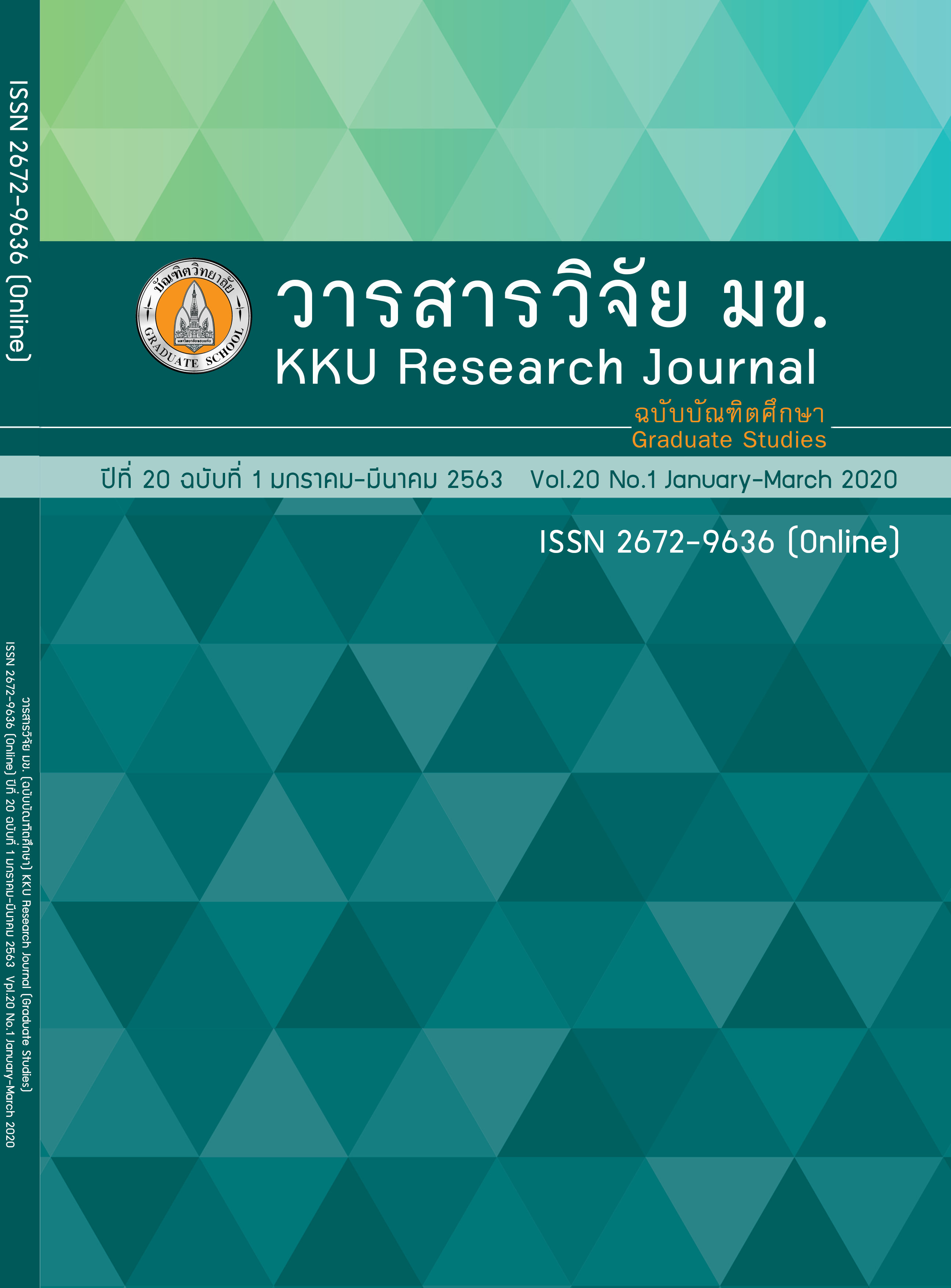อิทธิพลของจำนวนใบมีดและความเร็วเชิงเส้นของใบมีดสับที่มีผลต่อสมรรถนะ ของชุดสับลดขนาดลำต้นมันสำปะหลังสำหรับผลิตเป็นเชื้อเพลิงอัดเม็ด
คำสำคัญ:
จำนวนใบมีด, ความเร็วเชิงเส้นการสับ, ลำต้นมันสำปะหลังบทคัดย่อ
การศึกษามีวัตถุประสงค์เพื่อศึกษาอิทธิพลของ จำนวนใบมีด และความเร็วเชิงเส้นของใบมีดสับ ที่มีผลต่อสมรรถนะของชุดสับลดขนาดลำต้นมันสำปะหลัง เพื่อนำไปผลิตเป็นเชื้อเพลิงอัดเม็ด ลำต้นมันสำปะหลังพันธุ์ เกษตรศาสตร์ 50 มีความชื้น 9.85 เปอร์เซ็นต์มาตรฐานเปียกถูกนำมาทดสอบ โดยควบคุมอัตราการป้อน 130 กิโลกรัม/ชั่วโมง ปัจจัยที่ศึกษา ได้แก่ จำนวนใบมีด 3 ระดับ คือ 2 3 และ 4 ใบมีด และความเร็วเชิงเส้น 5 ระดับ คือ 4.12 5.03 5.95 6.80 และ 7.78 เมตร/วินาที ผลการศึกษา พบว่า จำนวนใบมีดสับ 2 ใบมีด และความเร็วเชิงเส้นของการสับ 5.03 เมตร/วินาที มีความสามารถในการทำงาน 115.30 กิโลกรัมต่อชั่วโมง ค่าพลังงานไฟฟ้า 1.28 กิโลวัตต์ ค่าพลังงานจำเพาะ 11.06 วัตต์-ชั่วโมง/กิโลกรัม และมีการกระจายขนาดของลำต้นมันสำปะหลัง 1-10 มิลลิเมตร รวมเท่ากับ 69.6 เปอร์เซ็นต์
References
FAO [Internet]. [Cited 2018 August 13]. Available from: http://www.fao.org/faostat/en/#data/QC. 2018.
AOAE [Internet]. [Cited 2017 January 23]. Available from: https://www.doae.go.th/doae/2016.
DEDE [Internet]. [Cited 2017 January 23]. Available from: http://www.dede.go.th. 2016.
Khidhathong P, Wangjiraniran W, Suriyawong A. A Study on Spatial Potential of Biomass for Electricity Generation. Journal of Energy Research 2014; 11(1): 63-76.Thai.
Kaewwinud N, Khokhajaikiat P, Boonma A. Effect of biomass characteristics on durability of Cassava stalk residues pellets. Research in Agricultural Engineering 2018; (1): 15–19.
Veiga J, José T, Feltranb C, Bizzoa W. Characterization and productivity of cassava waste and its use as an energy source. Renewable Energy 2016; (93): 691-699.
Wanbin Z, Torbjor N, Lestander. Cassava stems: a new resource to increase food and fuel. GCB Bioenergy 2015; (7): 72–83.
Jone D, Harper D, Taylor A. 2007. Wood Pellets – An introduction to their production and use [Internet]. 2007 [Cited 2020 February 1] Available from: https://extension.tennessee.edu/publications/Documents/W214.pdf.
Ladan J, Sokhansanj S, Mani S. Cost and Performance of Woody Biomass Size Reduction for Energy Production. The Canadian Society for Bioengineering 2006.
Hakkila P. Utilization of Residual Forest Biomass. Berlin: Springer-Verlag; 1989.
Visvanathan R, Sreenrayanan V, Swaminathan K. Effect of knife and velocity on the energy required to cut required to cut cassava tubers. Journal of Agriculture Engineering Research 1996; (64): 99-102.
Womac AR, Igathinathane C, Bitra P, Yang T, Sokhansanj. Biomass Pre-Processing Size Reduction with Instrumented Mill. The Proceeding of 2007 ASABE Annual International Meeting. Minesota: ASABE. 2007
Whittaker C, Shield I. Factors affecting wood, energy grass and straw pellet durability – A review. Renewable and Sustainable Energy Reviews 2017; (71): 1-11.
Jaya ST, Christopher T, Wright KL, Kenny J.A Review on Biomass Densification Technologies for Energy Application. Idaho Nationnal Labortory: Department of Energy National Laboratory; 2010 Aug. Report No.: INL/EXT-10-18420.
Tumuluru JS.High moisture corn Stover pelleting in a flat die pellet mill fitted with with a 6 mm die: physical properties and specific energy consumption. Energy science and engineering 2015; 3(4): 327-341.
Tumuluru JS, Wright CT, Kenny KL, Hess JR. A Review on Biomass Densifition Technologies for Energ Application. Idaho: Department Energy Systems and Technogies Division Idaho Falls; 2010
Abdallah R, Auchet S, Me´ausoone PJ. Experimental study about the effects of disc chipper settings on the distribution of wood chip size. Biomass and Bioenergy 2011; (35): 843-852.
ASAE. Moisture measurement –ungrounded grains and seeds. MI: American Society of Agricultural Engineers; 1994.
Oupathum C, Charee S, Sudajan S, Thivavarnvongs T. Effects of Moisture Content and Knife Bevel Angle on Shearing Properties of Cassava Stems. IOP Conf. Series: Earth and Environmental Science. IOP 2019; 301.
ASAE. Method of Determining and Expressing Particle Size of Chopped Forage Materials by Screening. MI: American Society of Agricultural and Biological Engineers; 1988.


